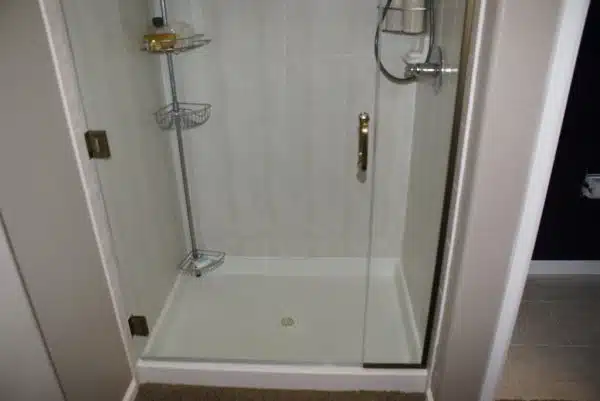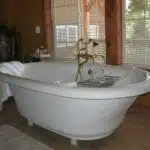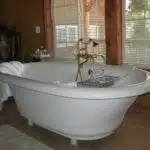As a shower size expert, it is important to understand the various standard sizes available for shower enclosures. When renovating or building a bathroom, choosing the right shower size can make all the difference in terms of functionality and aesthetics. Standard shower sizes are typically measured by square footage, and can range from small corner showers to large walk-in showers. It is essential to consider the available space in your bathroom, as well as your personal preferences and needs when selecting the appropriate shower size.
It is also important to note that there may be local building codes or regulations that dictate minimum shower sizes for safety reasons. Additionally, some homeowners may require specific features such as grab bars or seating areas in their shower which will influence the overall size and layout of the enclosure. By understanding what standard sizes are available and how they may impact your bathroom design, you can make informed decisions that will result in a beautiful and functional space for years to come.
Small Corner Showers
Step into a small corner shower and you’ll immediately notice how snug the space is. However, that doesn’t mean you have to compromise on style or comfort. In fact, there are plenty of space-saving designs and unique tile options available for those who want to make the most out of their compact shower.
One popular design option for small corner showers is the neo-angle enclosure. This type of shower has an angled shape that allows it to fit snugly into the corner of your bathroom while still providing a comfortable amount of space to move around in. Another option is a curved glass shower door, which can help to create the illusion of more space by eliminating any harsh corners or angles.
When it comes to tile options, consider using large-format tiles in light colors to help visually expand the space. Mosaic tiles are also a great choice for adding texture and interest without overwhelming the small area. With these design features in mind, you can create a beautiful and functional small corner shower that maximizes your bathroom’s potential.
As we move on to discussing square showers, keep in mind that even though they may offer slightly more room than their corner counterparts, there are still plenty of design challenges that come with working within a smaller footprint.
Square Showers
Small corner showers are an excellent option for those who are looking to save space in their bathroom. These types of showers come in a variety of sizes, but the most common size is 32 inches by 32 inches. Although small, these corner showers can provide an adequate showering experience for most people.
One of the main advantages of small corner showers is that they offer space saving solutions. These showers can be installed in a corner of a bathroom, which frees up more floor space for other fixtures or storage. However, installation challenges may arise due to the unique shape and location of these types of showers. It’s important to hire a professional installer who has experience with installing small corner showers to ensure that it’s done correctly.
If you’re looking for a larger shower option but still want to save space, consider square showers. Square showers typically measure around 36 inches by 36 inches and offer more room than small corner showers. They also offer space saving solutions since they can be installed in a corner as well. However, like with any type of shower installation, there may be some installation challenges that need to be addressed by a professional.
Next up is rectangular showers, which are another popular option among homeowners. These types of showers come in various sizes ranging from 48 inches by 36 inches to 72 inches by 48 inches. If you have more floor space available in your bathroom and enjoy taking long relaxing showers, then rectangular options might be the right choice for you.
Rectangular Showers
Rectangular showers are the most common type of shower enclosure. They come in a variety of sizes that can fit different bathroom layouts, from compact to spacious. The standard size for a rectangular shower is 36 inches by 48 inches, but larger sizes up to 60 inches by 42 inches or more are available.
Customization options for rectangular showers include glass enclosures, shower heads, and fixtures. Glass enclosures can be clear or frosted and can have different patterns and textures. Shower heads come in various shapes and sizes, including rain showerheads or handheld models. Fixtures such as knobs, handles, and drains also offer customization options.
Installation considerations for rectangular showers depend on the size and location of the installation. If the shower is being installed in a new construction project or a bathroom remodel, it’s important to consider water supply and drainage connections before installation begins. In some cases, additional plumbing work may be required to accommodate the shower’s size or layout.
Moving on to neo-angle showers, these unique shower enclosures are an excellent option for those looking to maximize space in their bathrooms while adding style and functionality.
Neo-Angle Showers
Neo-Angle Showers: Because Straight Lines Are Overrated
Ah, the classic shower shape – a simple rectangle. How boring. Why settle for ordinary when you can have something unique and stylish? Introducing the neo-angle shower! This modern design adds an exciting twist to your bathroom layout, with its distinctive angled walls that create a diamond-shaped enclosure.
But it’s not just about looks – these showers also offer practical benefits. The angled walls make them ideal for corner spaces, saving valuable floor space in smaller bathrooms. Plus, they provide a more spacious feel inside, with plenty of room to move around and stretch out. And don’t worry about water splashing outside the enclosure – the angled walls help contain it all within.
When it comes to customization options, neo-angle showers are quite versatile. You can choose from various sizes to fit your bathroom layout, and there are many styles of doors and frames available to match your decor. Installation requirements vary depending on the specific model you choose, but generally speaking, you’ll need a bit of extra space in the corner where you plan to install it.
- Imagine stepping into your own personal spa oasis with a frameless neo-angle shower.
- Want to add some drama? Opt for a black-framed neo-angle shower for a bold statement.
- For those who prefer simplicity, go with a clear glass panel and chrome hardware for a clean look that complements any style.
Next up: round showers – because why stop at angles when you can have curves?
Round Showers
Moving on from neo-angle showers, let’s explore another popular option for those looking to renovate their bathroom – round showers. One of the main factors to consider when choosing a round shower is the design – circular or quadrant. Circular showers have a completely round shape and are typically smaller in size compared to quadrant showers, which have a curved front and straight sides. Quadrant showers are ideal for larger bathrooms as they provide more space for movement inside the shower, while circular showers are perfect for smaller bathrooms where space is limited.
When it comes to the pros and cons of installing a round shower in your bathroom, there are several factors to keep in mind. One of the biggest advantages of round showers is their sleek and modern design that can easily elevate any bathroom decor. They also offer a unique and luxurious experience compared to traditional square or rectangular-shaped showers. On the other hand, one major disadvantage of round showers is that they can be more difficult to install due to their curved shape. Additionally, cleaning and maintenance can be tricky as well since some areas may be hard to reach.
In summary, if you’re considering a round shower for your bathroom renovation project, it’s important to weigh the pros and cons before making a decision. Consider factors such as your available space, budget, and personal preferences when selecting between circular or quadrant designs. Despite some potential drawbacks with installation and maintenance, a round shower can add both style and functionality to any bathroom space. Up next, we’ll take a closer look at walk-in showers and what they have to offer in terms of accessibility and convenience.
Walk-In Showers
As the name suggests, walk-in showers are designed to offer a seamless entrance into the shower area. These types of showers are perfect for people with mobility issues or those who prefer an open and spacious feel. A walk-in shower provides an inviting atmosphere that can make your bathroom feel like a luxurious spa.
Customization options are endless when it comes to walk-in showers. You can choose from a wide range of materials, including tile, stone, and glass. You can also customize the size and shape of the shower to fit your specific needs. This type of shower is also great if you want to create a unique look in your bathroom.
Cost considerations should be taken into account when deciding on a walk-in shower. While they may seem expensive at first glance, they can actually save you money over time by reducing water usage and increasing your home’s value. Plus, with so many customization options available, you can find a walk-in shower that fits your budget without sacrificing style or function.
Transitioning into the next section about bathtub-shower combos: If you’re looking for a way to maximize space in your bathroom while still enjoying the benefits of both a shower and bathtub, then a bathtub-shower combo may be right for you.
Bathtub-Shower Combos
- Bathtub-shower combos are a great option for those looking to combine their bathtub and shower in one unit.
- There are several types of bathtub-shower combos available, such as alcove tubs, corner tubs, and freestanding tubs.
- Installing a bathtub-shower combo is a great way to save space and make a bathroom more efficient.
- Benefits of bathtub-shower combos include added convenience and easy accessibility for those with limited mobility.
- When installing a bathtub-shower combo, it is important to consider the standard shower sizes and make sure that the combo will fit in the available space.
- For optimal results, it is recommended that a professional installer is hired to ensure the bathtub-shower combo is properly and safely installed.
Types Of Bathtub-Shower Combos
Are you considering installing a bathtub-shower combo in your bathroom? If so, there are several types of combos to choose from. One popular option is the compact design. These combos are ideal for small bathrooms where space is limited. They usually feature a smaller bathtub and shower area that can fit comfortably into a tight corner or alcove. Compact designs are also budget-friendly, making them an excellent choice for those who want to save money on their bathroom remodel.
Another type of bathtub-shower combo is the budget option. These combos are perfect for those who want to update their bathroom without breaking the bank. They often feature standard-sized bathtubs with a built-in showerhead, making them a practical and cost-effective solution. Budget options can be found in many different styles and finishes, so you’re sure to find one that complements your bathroom decor.
When choosing a bathtub-shower combo, it’s essential to consider your specific needs and preferences. Compact designs and budget options offer practical solutions for those looking to save space and money on their bathroom remodel. Whether you’re renovating a small guest bathroom or updating your master suite, there’s a combo out there that will meet your needs and exceed your expectations. So why wait? Start exploring your options today!
Benefits Of Bathtub-Shower Combos
Bathtub-shower combos are a popular choice for many homeowners looking to maximize the functionality of their bathroom space. One major benefit of these combos is their ability to provide space-saving solutions without sacrificing style or comfort. With compact designs and budget-friendly options available, bathtub-shower combos offer versatile design options that can fit any bathroom size and style.
In addition to saving valuable space, another advantage of bathtub-shower combos is their versatility in design. Whether you prefer a modern, sleek look or a classic, traditional style, there’s a combo out there that will complement your bathroom decor. You can choose from different materials such as acrylic, fiberglass, or ceramic for your tub and shower components, making it easy to customize your combo to suit your preferences.
Overall, bathtub-shower combos offer numerous benefits that make them an excellent investment for any homeowner. From providing space-saving solutions to offering versatile design options, these combos are practical and stylish choices for any bathroom remodel project. So whether you’re renovating a cramped guest bath or updating your luxurious master suite, consider installing a bathtub-shower combo for maximum comfort and convenience in your daily routine.
Installation Of Bathtub-Shower Combos
When it comes to bathroom remodeling, bathtub-shower combos are a popular choice for many homeowners. Not only do they save valuable space, but they also offer versatile design options that can complement any bathroom decor. However, before deciding on installing a bathtub-shower combo in your bathroom, it’s essential to consider the installation process and its associated costs.
The installation of bathtub-shower combos can be a complex process that requires the services of a professional plumber or contractor. The complexity of the installation depends on several factors such as the type of combo you choose, the size and layout of your bathroom, and any existing plumbing or electrical work. While hiring a professional can add to the overall cost of the project, it ensures that the installation is done correctly and efficiently.
One advantage of bathtub-shower combos’ installation is their ability to save time and money compared to separate installations of a tub and shower. By combining these two fixtures into one unit, you eliminate the need for extra plumbing and electrical work. Additionally, installing a combo is typically faster than separate installations, which means less disruption to your daily routine. However, it’s essential to weigh the pros and cons carefully before making a decision on whether or not to install one in your bathroom.
Space Considerations
When considering space limitations for a shower, there are a few important factors to keep in mind. First and foremost, it is important to consider the size of the bathroom overall. If the room is small, then it may be necessary to opt for a smaller shower size in order to maximize available space. Additionally, it is important to consider the placement of other fixtures within the bathroom, such as toilets or sinks. These features may impact where a shower can be installed.
Another important consideration when choosing a shower size is the placement of the shower head. In order to ensure that water is directed properly and does not splash outside of the shower area, careful thought should be given to where the shower head will be located. This will also help determine whether a larger or smaller shower size is needed.
Glass door options can also play a role in determining what size shower is best for a particular space. Sliding doors or pivot doors can help save space compared to traditional hinged doors that swing outwards. Additionally, clear glass doors can make small spaces appear larger by allowing light to pass through and creating an unobstructed view.
- Consider overall bathroom size when choosing a shower size.
- Placement of other fixtures within the bathroom may impact where a shower can be installed.
- Careful consideration should be given to where the shower head will be placed.
- Glass door options such as sliding or pivot doors can save space and create an unobstructed view.
When it comes down to it, choosing the right shower size ultimately depends on personal preferences and practical considerations based on individual bathroom layouts and sizes. In the next section, we will explore some common preferences people have when selecting their ideal shower dimensions and features.
Personal Preferences
The size of a shower is not only determined by the dimensions of the bathroom but also by personal preferences. The type of showerhead options and tile choices can contribute to making a shower feel more spacious, even if it has smaller dimensions. For those who prefer a more luxurious shower experience, a larger shower size may be desired.
When considering personal preferences for shower sizes, it is important to take into account the available space in the bathroom. A small bathroom with limited square footage might require a compact-sized shower stall. However, with clever design choices and the right tile selections, the space can be made to feel larger and more open. On the other hand, larger bathrooms can allow for more generous-sized showers that offer a sense of luxury and comfort.
Showerhead options and tile choices can significantly impact how large or small a shower feels. A rainfall showerhead offers a spa-like experience that can make a smaller sized-shower feel much grander. Similarly, ceramic tiles in lighter colors reflect light well, providing an illusion of more space in smaller showers. Large format tiles are another option that can help minimize grout lines and make for easier cleaning while adding to an overall modern aesthetic.
As we have seen, personal preferences play an important role when choosing the right size for your new shower. Additionally, there are many design elements such as tile selection and showerhead options that can help create an illusion of space regardless of actual dimensions. In our next section, we will explore safety regulations that should be considered when selecting your ideal shower size.
Safety Regulations
As a shower size expert, it is important to take into account safety regulations and building codes. These standards are put in place to ensure that the showers are safe and accessible for all users. Building codes vary by location, but many require a minimum interior shower size of 30 inches by 30 inches. However, this may not be sufficient for some users.
It is important to consider accessibility features when choosing a shower size. This includes ensuring that the shower has enough space for a wheelchair or other mobility aid, as well as grab bars or support rails to assist with getting in and out of the shower. Additionally, the height of the showerhead and controls should be adjustable to accommodate users of different heights.
When selecting a standard shower size, it is important to keep in mind that safety and accessibility should always come first. While there may be personal preferences for larger or smaller showers, it is essential to adhere to building codes and safety regulations to ensure a safe and comfortable experience for all users. In the next section, we will discuss some accessibility features that can further improve the safety and usability of your shower space.
Accessibility Features
When it comes to creating an accessible shower, universal design and ADA compliance should be at the forefront of considerations. Universal design is about creating spaces that are usable for everyone, regardless of age or ability. This means incorporating features that make the space easy to navigate, such as wider doorways and barrier-free entryways. For showers, this can mean choosing a size that allows for wheelchair access and installing a bench or seat.
One important feature of an accessible shower is grab bars. These bars provide support for those with mobility issues and can help prevent slips and falls in wet environments. When selecting grab bars, it’s important to ensure they meet ADA compliance standards, which include being securely mounted and able to withstand 250 pounds of weight.
Another consideration for an accessible shower is the location of controls and fixtures. They should be easy to reach from a seated position and have clear labeling for those with visual impairments. Additionally, non-slip flooring should be used to prevent accidents.
- Consider incorporating universal design principles into your shower design
- Ensure grab bars meet ADA compliance standards
- Place controls and fixtures within easy reach from a seated position
When creating an accessible shower, there are several factors to consider beyond just the size. By incorporating universal design principles, ensuring ADA compliant grab bars are installed, and placing controls within easy reach, you can create a safe and functional space for all users. The next section will cover more about selecting the right grab bars for your needs.
Grab Bars
As an expert in shower sizes, it is important to consider the installation methods and material options available for standard showers. The most common installation method is the alcove shower, which fits into a three-wall enclosure with a door on one side. This type of shower is typically made from fiberglass or acrylic materials, which are lightweight and easy to clean. Another option is the corner shower, which fits into a two-wall corner and can be made from similar materials.
For those who prefer a more luxurious shower experience, there are also custom-built showers that can be designed to fit any space and style. These showers can be made from a variety of materials such as tile or natural stone, but require professional installation and may come at a higher cost than standard models. It’s important to consider both the practicality and aesthetic appeal when choosing between standard and custom-built showers.
When selecting shower materials, it’s important to choose durable options that will withstand daily use without showing wear or damage over time. Common material options include fiberglass, acrylics, porcelain-coated steel, and natural stone such as granite or marble. Each material has its own unique advantages and drawbacks in terms of appearance, durability, maintenance requirements, and cost. As an expert in shower sizes, I recommend consulting with a professional contractor or designer to determine the best material option for your specific needs and budget.
As we move onto the topic of seating areas in standard showers, it’s important to note that these features can greatly improve accessibility for those with mobility issues or disabilities. Seating areas can range from built-in benches to fold-down seats that are attached directly onto the wall. These options provide added comfort and safety while also allowing users to sit while showering if needed. When considering seating options for your standard shower, be sure to choose sturdy materials that will support weight without compromising safety or stability.
Seating Areas
Seating Areas: A Place to Relax and Unwind
Just like a warm shower can wash away the stresses of the day, a comfortable seating area in your shower can provide a space to relax and unwind. Seating areas come in many different shapes and sizes, from built-in benches to freestanding stools. Regardless of which option you choose, adding a seating area to your shower is an excellent way to make it more functional and enjoyable.
A built-in bench is a popular choice for those looking to add a seating area to their shower. These benches are typically made from tile or stone and can be customized to fit any size or shape of the shower. They are also incredibly durable and easy to clean, making them an excellent option for busy households. Alternatively, freestanding stools offer a more flexible seating option that can be easily moved around as needed.
Markdown bullet points:
- Built-in benches are a popular choice for permanent seating areas.
- Freestanding stools offer more flexibility in terms of placement and design.
- Seating areas allow for relaxation while taking a shower.
- Adding a seating area can make your shower more functional.
- There are many different options available when it comes to choosing a seating area for your shower.
As an expert on all things related to showers, I highly recommend considering adding a seating area to your bathroom remodel plans. Not only does it provide an additional element of luxury and relaxation, but it also adds practicality by providing extra storage space underneath the bench or stool. Whether you opt for a built-in bench or freestanding stool, incorporating this feature into your design will undoubtedly enhance the overall experience of using your shower.
With so many options available when it comes to designing your perfect bathroom oasis, there are several important considerations you’ll want to keep in mind. From choosing the right size shower stall to selecting complementary tile patterns, every detail matters when creating your dream space. In the next section, we’ll discuss some essential design considerations to keep in mind as you move forward with your bathroom renovation plans.
Design Considerations
When it comes to designing your shower space, there are a few considerations you should keep in mind before finalizing your plans. One of the most important things to think about is the overall layout of your shower. Depending on the size and shape of your bathroom, you may have limited options for where to place your shower. However, if you have some flexibility in this regard, it’s worth considering different layouts to see what will work best for your needs.
Another key factor to consider is the type of tile pattern that will be used in your shower. While this may seem like a small detail, the pattern can have a significant impact on the overall look and feel of your space. Some popular choices include subway tiles, mosaic patterns, and hexagonal tiles. Ultimately, the choice will depend on personal preference as well as the style of your bathroom.
Overall, when designing a shower space, it’s important to keep both aesthetics and functionality in mind. By choosing a layout and tile pattern that work well together and suit your needs, you can create a space that not only looks great but also performs well over time. In the next section, we’ll explore some tips for ensuring long-term functionality when designing your shower space.
Long-Term Functionality
As the saying goes, “An ounce of prevention is worth a pound of cure.” This holds true for shower sizes as well. Long-term functionality should be one of the primary considerations when selecting a shower size. A well-designed shower can go a long way in saving you from expensive repairs and replacements in the future.
To ensure that your shower lasts for years to come, it is essential to invest in cost-effective solutions. While larger showers may seem tempting, they often come with higher installation costs and increased maintenance expenses. Opting for a standard size shower is not only budget-friendly but also easier to maintain over time.
Regular maintenance is crucial for any type of shower, regardless of its size. Simple maintenance tips like cleaning the tiles and grout regularly or fixing leaks as soon as they occur can prevent costly water damage and mold growth. By following these simple steps, you can extend the life of your shower and avoid unnecessary expenses down the line.
By selecting a standard-sized shower and investing in regular maintenance practices, you can ensure that your bathroom remains functional and beautiful for years to come. Remember, prevention is always better than cure, so take care of your shower now to save yourself from headaches later on!
Conclusion
When it comes to choosing the right shower size for your bathroom, there are a few things to consider. Small corner showers are ideal for compact spaces, while square and rectangular showers provide more room. Neo-angle showers are great for those looking for a unique design, and round showers offer a luxurious feel. It’s important to also consider practical elements such as grab bars and seating areas.
Design considerations should not be overlooked, as the shower can be a focal point of the bathroom. However, long-term functionality is equally important. A well-designed shower should not only look good but also stand the test of time.
As an expert in shower sizes, I recommend carefully considering your space and needs before selecting a shower size. Don’t be afraid to think outside the box with unique designs or add practical elements such as grab bars for safety. Your chosen shower should not only fit your style but also provide long-lasting functionality that you’ll appreciate every day. Remember that finding the perfect size is like finding the perfect fit – it may take some time, but it will ultimately result in a comfortable and enjoyable experience every time you step into your new shower.
Image Credits
- “Shower Door replacement, Master shower” by 1koolkat (featured)





























